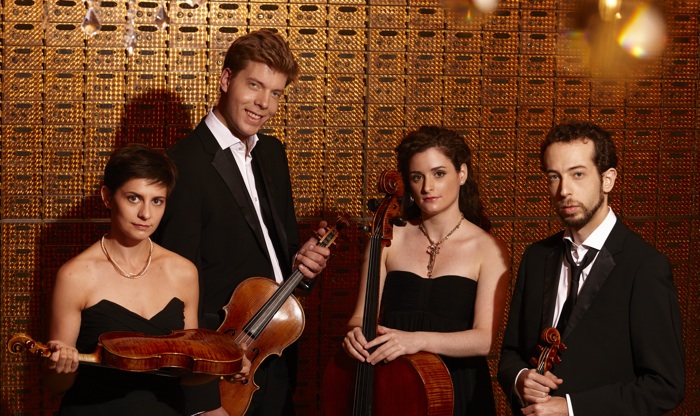The end of a Napa summer, and of a cycle
Music in the Vineyards, Napa Valley’s long running chamber music festival, closed last weekend with the complete Beethoven cycle. The Ariel quartet performed all 16 of these masterly quartets over five days, held at five different vineyards around the Valley. Each concert combined early, middle and late quartets for a deeper view into a mind that reinvented Western music. On Saturday, Aug. 20, I got to visit the Jamieson Ranch Vineyards and hear the Ariel Quartet perform the delightful Opus 18, No. 3, romp through Opus 59, No. 1, and work their way through a quintessential mold-breaker, the Opus 131.
Winery owners Anna and Bill Leigon welcomed us to their upstairs Great Hall, a vaulted space of redwood trusses and beams that was acoustically bright and warm. Bill described their support of the arts and then quoted Mother Teresa: “We do no great things in life, but small things with great love.” That love was visible around the estate in other details, and I learned that the lively murals covering the southern walls were created as a fundraiser for school arts programs, and a large horse sculpture at the entrance referred to another of their programs, school visits with miniature horses to engage special-needs children.
 He was followed on stage by conductor/musicologist Nuvi Mehta, who introduced each piece and gave us some insights into it. “The D Major Opus 18 is numbered No. 3 but was actually the first quartet Beethoven wrote. He wrote and then reworked all of them heavily. It is almost Haydn, following that [inventor of the quartet form], and ends with a wild flurry that is clearly competitive with Haydn. The first two notes, a flat seventh interval, are inherently unstable. Think of the first two notes of Bernstein’s ‘There’s a place for us’ [from West Side Story], also a flat seventh interval.”
He was followed on stage by conductor/musicologist Nuvi Mehta, who introduced each piece and gave us some insights into it. “The D Major Opus 18 is numbered No. 3 but was actually the first quartet Beethoven wrote. He wrote and then reworked all of them heavily. It is almost Haydn, following that [inventor of the quartet form], and ends with a wild flurry that is clearly competitive with Haydn. The first two notes, a flat seventh interval, are inherently unstable. Think of the first two notes of Bernstein’s ‘There’s a place for us’ [from West Side Story], also a flat seventh interval.”
Russian violinist Alexandra Kazovsky gloried in those two long notes, an unstable beginning that could not help but propel a cascade of notes, which she twirled through as the others bowed long sumptuous chords. German violist Jan Grüning repeated the theme, embracing that unstable entrance with deep resonance and the familiarity of a newfound friend. Each took their turn while the other three created tensions and pairings, pregnant pauses and quick-turns, Beethoven’s young and unbridled inventiveness.
The Adagio lingered on fat chords, then minced through short notes that were almost self-mocking, and then returned to bittersweet. Israeli cellist Amit Even-Tov filled the hall with generous bottom notes and brought a cool beauty to her mid-range.
The Scherzo was a lovely minuet, with a gypsy motif that passed around midstream, and the final Allegro, as Mehta had said, “out-Haydned Haydn.” This was a work of self-awareness, sweetness and curiosity from one better known as a brilliant curmudgeon, and, in the hands of the Ariel Quartet, was delivered fresh.
From his first quartet we moved ahead to Beethoven’s seventh quartet, the Opus 59, No. 1 in F major. It was the first of three quartets commissioned by the Russian ambassador to Vienna, Prince Razumovsky, and it opens with the cello playing a gentle melody over soft nubbins from the others.
Israeli Gershon Gerchikov played the second violin in the No. 18, but here he took the lead, playing the higher violin part with sinewy notes that had equal parts delicacy and steel. There were rising cadences and sudden contrasts, a deft tapestry of intimacy and fierceness and great height. In the first movement his traceries were like the outlines of clouds, busy and serene iterations that built over rich and contradictory chords. It truly felt like a Nature event, a portrait of Forces that test human significance.
The Adagio was majestic, thick harmonies with slow resolutions, and that slow turning let us glory in the tight discords. And then they turned light-hearted in the finale, running for the hills.
And all of this was preparation. Mehta continued: “With the late quartets, Beethoven entered ethereal territory. It was music for the future.”
The Opus 131 in C sharp minor was written late in life, and was said to have been Beethoven’s own favorite. Each string entered with a theme that strove upward and then fell back. As each crested, the other three created deep billows on a sea of sound, low chords that shifted and slid, a reverberant undertow. It was the epitome of tragic.
And then, as if they were the bright memories of a dying man, the Ariel Quartet treated us to the lightness of dance, a song of a young heart, slow variations with teasing harmonies, bits of lullaby, and wedges of teeth-gritting sound. It was contradictory and mercurial, and described by scholars as “elusive.”
After light and love and inventiveness they drew a fierce low chord and returned us to the deep melancholy of the opening, and a return to that C-sharp minor. And that ushered in the finale, a fierce rhythmic gallop that instantly reminded me of Schubert’s ride of the chariot of Death. It was chilling and awe-inspiring, a proud mind casting its light into the darkness ahead.
This was the beginning and end of a journey that shook the world, and a reminder that what little we can do in this life, we can do with great love.
—Adam Broner
Photos: top, of a new mural from the Fresh Coat project at Jamieson Ranch Vineyards, benefitting the Aldea Art Therapy programs; below, of the Ariel Quartet, from left, Alexandra Kazovsky, Jan Grüning, Amit Even-Tov and Gershon Gerchikov, photo courtesy of the artists.

